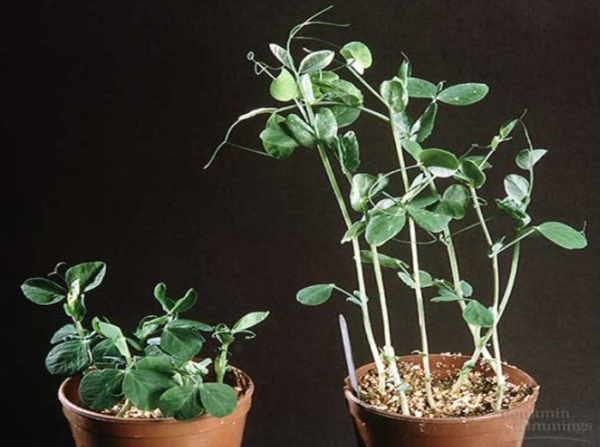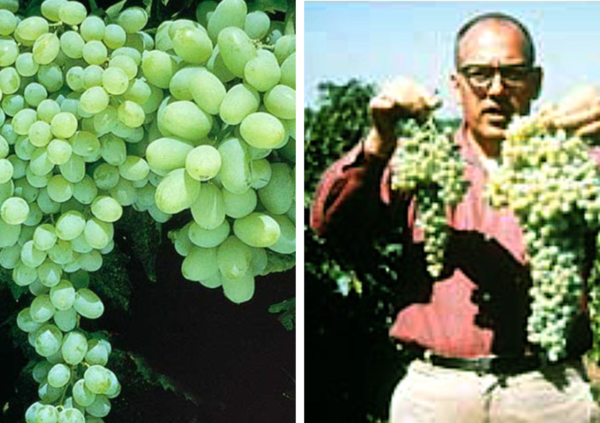Dr. Lew Feldman, Garden Director
In a previous IGYA we began discussing the regulation of growth and development in plants via signaling molecules and focused on the naturally occurring compound known as auxin. In this write-up, we will consider a second group of signaling molecules called the gibberellins (abbreviated GA). As with auxin, in discussing the gibberellins, I will focus on the practical applications (horticultural uses) of this group of signaling molecules.
The discovery of the gibberellins is attributed to Japanese scientists in the 1920’s. They investigated a fungus pathology that caused rice plants to become very tall and spindly, resulting in the rice seed heads easily falling over into the water. The rice was growing before the seeds could be harvested. The substance causing the elongation of the plant stems was isolated and given the name gibberellin (GA). But even though the GA was initially discovered as a fungal by-product, we now know that all plants naturally produce gibberellins. And they are part of the mechanisms by which plants regulate their growth and development.
Given the history of GA’s discovery, the first horticultural insights about GA signaling in plants were associated with plant height control or stature. Many dwarf horticultural varieties are of short stature because their GA machinery has been either naturally, or by humans, perturbed or mutated. In cases where the normal level of GA has been reduced, perhaps by a mutation, treating such plants with GA can restore the typical stature, as pictured below in dwarf pea plants.

On the left is a pot of untreated (control) dwarf pea plants and on the right is a pot of dwarf pea plants treated with GA. Note that the stems (internodes) of the GA-treated plants have greatly elongated (SlidePlayer).
Flowering
As our experience tells us, gibberellins can profoundly affect flowering; most plants flower at a particular time of the year. Plants that flower when the days are long (during the summer), are called long-day-plants, whereas plants that bloom in late fall or early spring, when the number of hours of light are less, are called short-day-plants. GA can stimulate long day-plants to flower, even if these plants are kept in short days, whereas GA is without effect on short-day plants’ flowering time. This allows us to have long-day-plants in flower any time of the year. For horticulturists and nursery personnel, GA treatments can dramatically promote flowering and reduce the time to flowering in many plants. Pre-treating many rhizomes and tubers with GA, such as those of calla lily, can greatly accelerate flowering and increase the number and size of flowers. For those of you who attend Camellia shows, you’ll note that the winning flowers are often of extraordinary size. This is because the individuals who enter blooms in Camellia show frequently treat the developing, small flower buds with GA. The process of applying GA to camellias is called “gibbing.” For those of you interested in learning more about this technique, you can have a look at the following Youtube video.
Fruit Development
Another common horticultural practice involving GA relates to fruit development. Many fruits can be stimulated to enlarge as a result of gibberellin applications. Perhaps the most common use of GA is on grapes. Typically, many varieties of grapes produce round-shaped fruits. However, treating such grapes with GA causes them to elongate greatly, becoming oval, increasing in size and weight, and costing more at the produce store. The increase in fruit size is associated with more water moving into the treated fruit, but there is no increase in nutritional value. Next time you are in a produce market, look at the grapes, and see if you can determine which have likely been treated with GA.

GA treatments affect grape size and shape. For both pictures, the untreated grapes are on the left, and GA-treated grapes are on the right (Pinterest and Euorpeanmedical).
Seed germination
Gibberellins are involved in the natural process of breaking seed dormancy. This understanding underlies the horticultural practice of using gibberellins to stimulate (speed up) seed germination. Many seeds have evolved mechanisms for “determining” when the environment is most suitable to germinate. For example, in cold climates, recently-germinated seedlings produced in the fall would likely be killed by the winter cold. Thus, seeds have evolved mechanisms for preventing germination until a suitable climate has returned. For such seeds, gibberellins are usually involved with stimulating seed germination. Gibberellins are absent in the recently produced seed and only reach a level high enough to stimulate germination in the spring, after a long period of cold. Thus, treating many kinds of dormant seeds with GA substitutes for a cold treatment and stimulating the otherwise dormant seeds to germinate is the horticultural practice.
The mechanisms by which GA stimulates seed germination have been a topic of study by many researchers and have been shown to promote the conversion of stored starch to sugar, an essential step for germination. Economically, one of the most important GA uses is in the beer brewing industry, in which one of the earliest steps in this process involves treating barley seeds with GA. This causes the stored starch to be converted to sugar, resulting in a product known as “the malt,” which is then used by microorganisms (yeasts) to make alcohol. Malted grains are also used in whisky making, in flavored drinks such as Ovaltine, and some baked goods, such as bagels and tea biscuits.
